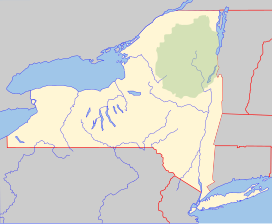| Owls Head Mountain | |
|---|---|
 The Fire Tower on Owls Head Mountain | |
| Highest point | |
| Elevation | 2,786 feet (849 m)[1] |
| Coordinates | 43°57′16″N 74°29′56″W / 43.9545057°N 74.4987761°W[1] |
| Geography | |
| Location | Hamilton County, New York, U.S. |
| Topo map | USGS Deerland |
Owls Head Mountain is a 2,786-foot-tall (849 m) mountain in the Adirondack Mountains region of New York. It is located west-southwest of the hamlet of Long Lake in Hamilton County.

It can be climbed from a trailhead on Endion Road off New York Route 30, just north of the hamlet of Long Lake. The trail provides a 3.2-mile (5.1 km) ascent with a gain of 1,200-foot (370 m); a side trail leads to Lake Eaton. The view from the summit includes 14-mile (23 km) Long Lake, part of the Raquette River. The Owls Head Mountain Forest Fire Observation Station, a 35-foot-tall (11 m) Aermotor steel fire tower affords a 360-degree view of the central Adirondacks and Adirondack High Peaks region; nearer peaks include Kempshall Mountain on the shore of Long Lake, and the fire towers of Blue Mountain, Wakely Mountain, Snowy Mountain, Goodnow Mountain and Mount Arab. The trail to the summit passes the foundation of the old fire observer's cabin.
After a 1908 forest fire destroyed nearby Long Lake West (now known as Sabattis), New York State Conservation Department built a wooden fire tower on Owls Head Mountain in 1911 that was replaced in 1919 by the present tower. The tower was closed in 1970 as airplanes replaced fire observers. It has been restored and opened to the public.
References[edit]
- ^ a b "Owls Head Mountain". Geographic Names Information System. United States Geological Survey, United States Department of the Interior. Retrieved December 2, 2021.
External links[edit]
- Summit Post
- Saranac Lake.com
- The Fire Towers of New York
- Fire Observation Stations of New York State Forest Preserve MPS


Well, that’s interesting to know that Psilotum nudum are known as whisk ferns. Psilotum nudum is the commoner species of the two. While the P. flaccidum is a rare species and is found in the tropical islands. Both the species are usually epiphytic in habit and grow upon tree ferns. These species may also be terrestrial and grow in humus or in the crevices of the rocks.
View the detailed Guide of Psilotum nudum: Detailed Study Of Psilotum Nudum (Whisk Fern), Classification, Anatomy, Reproduction